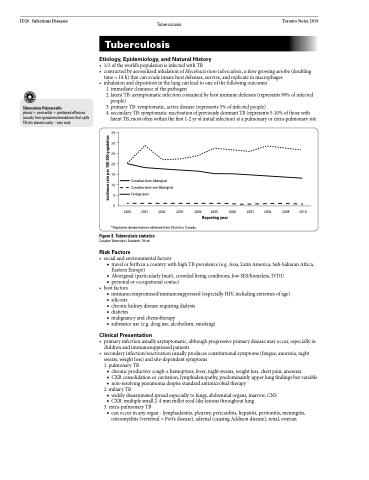Page 626 - TNFlipTest
P. 626
ID26 Infectious Diseases
Tuberculous Polyserositis
pleural + pericardial + peritoneal effusions (usually from granuloma breakdown that spills TB into pleural cavity – very rare)
Tuberculosis Toronto Notes 2019 Tuberculosis
Etiology, Epidemiology, and Natural History
• 1/3oftheworld’spopulationisinfectedwithTB
• contractedbyaerosolizedinhalationofMycobacteriumtuberculosis,aslowgrowingaerobe(doubling
time = 18 h) that can evade innate host defenses, survive, and replicate in macrophages • inhalationanddepositioninthelungcanleadtooneofthefollowingoutcomes
1. immediate clearance of the pathogen
2. latent TB: asymptomatic infection contained by host immune defenses (represents 90% of infected
people)
3. primary TB: symptomatic, active disease (represents 5% of infected people)
4. secondary TB: symptomatic reactivation of previously dormant TB (represents 5-10% of those with
latent TB, most often within the first 1-2 yr of initial infection) at a pulmonary or extra-pulmonary site
35 30 25 20 15 10
5 0
*Population denominations obtained from Statistics Canada
Figure 8. Tuberculosis statistics
Canadian Tuberculosis Standards, 7th ed.
Risk Factors
Canadian-born Aboriginal Canadian-born non-Aboriginal Foreign-born
2000 2001 2002 2003 2004 2005 2006
2007 2008
2009 2010
Reporting year
• socialandenvironmentalfactors
■ travel or birth in a country with high TB prevalence (e.g. Asia, Latin America, Sub-Saharan Africa,
Eastern Europe)
■ Aboriginal (particularly Inuit), crowded living conditions, low SES/homeless, IVDU ■ personal or occupational contact
• hostfactors
■ immunocompromised/immunosuppressed (especially HIV, including extremes of age) ■ silicosis
■ chronic kidney disease requiring dialysis
■ diabetes
■ malignancy and chemotherapy
■ substance use (e.g. drug use, alcoholism, smoking)
Clinical Presentation
• primaryinfectionusuallyasymptomatic,althoughprogressiveprimarydiseasemayoccur,especiallyin children and immunosuppressed patients
• secondaryinfection/reactivationusuallyproducesconstitutionalsymptoms(fatigue,anorexia,night sweats, weight loss) and site-dependent symptoms
1. pulmonary TB
■ chronic productive cough ± hemoptysis, fever, night sweats, weight loss, chest pain, anorexia
■ CXR consolidation or cavitation, lymphadenopathy, predominantly upper lung findings but variable ■ non-resolving pneumonia despite standard antimicrobial therapy
2. miliary TB
■ widely disseminated spread especially to lungs, abdominal organs, marrow, CNS ■ CXR: multiple small 2-4 mm millet seed-like lesions throughout lung
3. extra-pulmonary TB
■ can occur in any organ - lymphadenitis, pleurisy, pericarditis, hepatitis, peritonitis, meningitis,
osteomyelitis (vertebral = Pott’s disease), adrenal (causing Addison disease), renal, ovarian
Incidence rate per 100,000 population


